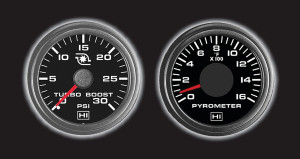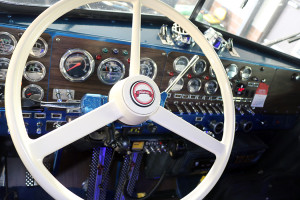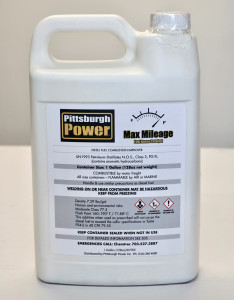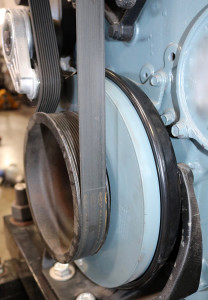 Every day I am amazed at how many owner operators do not know how many pounds of turbo boost their truck can develop, how many pounds of boost it takes to travel across the level highways at their cruising speed, and what happens when the engine is low on turbo boost. The turbo boost gauge is one of the most important gauges in the instrument panel. If you don’t drive with one eye on the turbo boost gauge, you are not getting optimal fuel mileage.
Every day I am amazed at how many owner operators do not know how many pounds of turbo boost their truck can develop, how many pounds of boost it takes to travel across the level highways at their cruising speed, and what happens when the engine is low on turbo boost. The turbo boost gauge is one of the most important gauges in the instrument panel. If you don’t drive with one eye on the turbo boost gauge, you are not getting optimal fuel mileage.
For trucks 2002 and older, most engines that develop 500 horsepower need 30 psi of boost to keep the exhaust gas temperature (EGT) at a safe level so you don’t melt pistons (if they are aluminum). If the engine has steel pistons, the excessive heat can take the tension out of the piston rings. Excessive exhaust heat will also burn the cast iron exhaust manifold and the cast iron turbine of the turbocharger. If you have a 500-hp engine and the turbo boost is decreasing a few pounds every day, there is a problem – don’t keep driving the truck. Every pound of turbo boost lost will raise the EGT by 25 degrees. Recently, we have had two owner operators driving their trucks with a loss of 10 psi of boost, which raises the exhaust gas temperature 250 degrees, and takes your engine beyond the danger point. By driving a truck with this issue, you are decreasing the life of your engine.
 Now here is another problem: many owner operators buy used company trucks, which do not have a turbo boost gauge or exhaust gas temperature gauge (pyrometer). Fleet managers say their drivers are not smart enough to read the gauges and can’t drive a 13- or 18-speed transmission. Now, Mr. Owner Operator purchases these single stack trucks with a 10-speed and no gauges and goes to work. First complaint – no power and no fuel mileage. That’s right, low power equates to poor fuel mileage. So, you call or talk to us on the radio show and what is the first thing I ask? How much turbo boost does the engine develop on a hard pull with your foot on the floor? And you answer, “This is an ex-fleet truck and it doesn’t have those gauges.”
Now here is another problem: many owner operators buy used company trucks, which do not have a turbo boost gauge or exhaust gas temperature gauge (pyrometer). Fleet managers say their drivers are not smart enough to read the gauges and can’t drive a 13- or 18-speed transmission. Now, Mr. Owner Operator purchases these single stack trucks with a 10-speed and no gauges and goes to work. First complaint – no power and no fuel mileage. That’s right, low power equates to poor fuel mileage. So, you call or talk to us on the radio show and what is the first thing I ask? How much turbo boost does the engine develop on a hard pull with your foot on the floor? And you answer, “This is an ex-fleet truck and it doesn’t have those gauges.”
The turbo boost gauge is $68.00, and you can install it in your driveway with simple hand tools. The exhaust gas temperature gauge works hand-in-hand with the boost gauge. If the boost is decreasing and the exhaust gas temperature is going up, there is a boost leak, turbo problem, clogged or wet air filter, or a crack in the charge air cooler. If the boost is decreasing and the exhaust gas temperature is also decreasing, there is a fuel problem. It takes fuel to make boost and exhaust heat, so if the fuel delivery is decreasing, the exhaust gas temperature is also decreasing, along with the turbo boost. When you, the driver and/or owner of this truck, give us these numbers, we can help you find the problem. The pyrometer kit it $178.00, and if you have a drill with a 7/16 bit, you can install it in your driveway.
 On to the next topic: harmonic balancers – there is no such item, it’s called a torsional damper, and this is a wear item, which means it wears out like a tire and a shock absorber. In fact, it is a shock absorber for the crankshaft. Every time an injector fires and the piston is slammed to the bottom of the stroke, the large steel ring in the torsional damper moves slightly to absorb the shock and remove torsional vibrations. This steel ring rides on Teflon and is cushioned by very thick silicone. As the Teflon wears, the silicon starts to harden at about 380,000 miles. At 500,000 miles the silicone is hard, and the large steel ring can no longer move to remove the torsional vibrations and shock from the piston coming to the bottom of the stroke. Did you know, at 1,400 RPM, in one mile, there are 700 injections of diesel fuel, and the large steel ring in the torsional damper has to absorb all 700 of the power strokes of the pistons? Every day on the phone I hear, “My mechanic says we never change those, they don’t wear out.” If this the case, please tell your mechanic to go on our website and look at the video pertaining to torsional dampers!
On to the next topic: harmonic balancers – there is no such item, it’s called a torsional damper, and this is a wear item, which means it wears out like a tire and a shock absorber. In fact, it is a shock absorber for the crankshaft. Every time an injector fires and the piston is slammed to the bottom of the stroke, the large steel ring in the torsional damper moves slightly to absorb the shock and remove torsional vibrations. This steel ring rides on Teflon and is cushioned by very thick silicone. As the Teflon wears, the silicon starts to harden at about 380,000 miles. At 500,000 miles the silicone is hard, and the large steel ring can no longer move to remove the torsional vibrations and shock from the piston coming to the bottom of the stroke. Did you know, at 1,400 RPM, in one mile, there are 700 injections of diesel fuel, and the large steel ring in the torsional damper has to absorb all 700 of the power strokes of the pistons? Every day on the phone I hear, “My mechanic says we never change those, they don’t wear out.” If this the case, please tell your mechanic to go on our website and look at the video pertaining to torsional dampers!
We’ve been getting a lot of questions about our Max Mileage Fuel Borne Catalyst, so we’d like to address them here. A common question is, if you have an older truck without a DPF, will you benefit from this product? The answer is yes. It still makes for a better running engine with a more complete combustion, so you’ll notice a smoother running engine and slightly better mileage. The Max Mileage product will also save your engine from carbon buildup in the combustion chamber, which helps to extend ring and liner life, and in the exhaust manifold and turbo, which will alleviate reduced performance.
 Another common question about our new Max Mileage product is, should you still get a Diesel Force engine cleaning done in addition to using the Max Mileage? The answer to that is absolutely. The Diesel Force will give your engine a fresh start before using the Max Mileage to keep it clean. The Max Mileage burns off soot starting at 700 degrees. Regen programs are designed to increase exhaust gas temperature as high as 1,200 degrees to burn off the soot and carbon. So, Max Mileage does a good job at keeping the hotter parts of the system clean. Diesel Force will clean all the other parts that don’t get hot. So, really, it’s necessary to do both, if soot is a problem for you.
Another common question about our new Max Mileage product is, should you still get a Diesel Force engine cleaning done in addition to using the Max Mileage? The answer to that is absolutely. The Diesel Force will give your engine a fresh start before using the Max Mileage to keep it clean. The Max Mileage burns off soot starting at 700 degrees. Regen programs are designed to increase exhaust gas temperature as high as 1,200 degrees to burn off the soot and carbon. So, Max Mileage does a good job at keeping the hotter parts of the system clean. Diesel Force will clean all the other parts that don’t get hot. So, really, it’s necessary to do both, if soot is a problem for you.
Please don’t forget about the Safe-T-Plus steering stabilizer, which I talked about last month. Yes, it’s expensive ($699.00 for the unit and installation kit), but it can be easily installed in your driveway. This unit will hold the truck straight down the highway, remove shock from the steering wheel, and give you more control if you drift off the highway. If you blow a front steering tire, all you need is one hand on the steering wheel to maintain complete control of the truck. If you have a car hauler, this item is a necessity, due to the extra weight on the front axle. Give us a call at (724) 360-4080 if you have questions about the products mentioned here or want to make an order or visit www.pittsburghpower.com to learn more.
